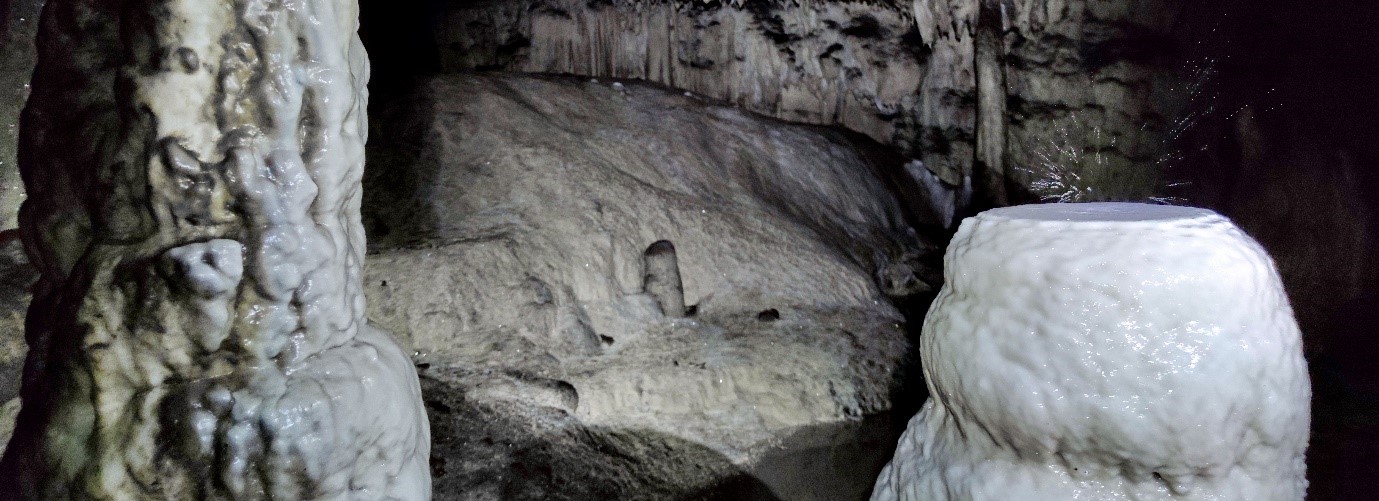Palaeoenvironment and palaeoclimate

Palaeoenvironments and palaeoclimates are intrinsically connected to physical geography as they offer crucial insights into the Earth's past landscapes, climatic conditions, and geomorphological processes, which are foundational for understanding present and predicting future geographical phenomena. These concepts are deeply interwoven with other main research themes of our Department, such as karst in Plio-Quaternary rocks, where they help elucidate the formation and evolution of karst landscapes under varying climatic regimes; the cryosphere, where understanding glacial cycles and ice extent is essential to understand past climate conditions; and slope processes, where historical climate data contribute to understanding the triggers and frequencies of mass wasting events, shaping the terrain over geological timescales.
Recent projects:
- Supporting Holocene Climate Reconstruction with High-Resolution Cryospheric Proxies from the Karst Ice Caves of Slovenia - Slovenian Research and Innovation Agency - 2023-2026
- The impact of climate change on avalanches in Slovenia - Slovenian Research and Innovation Agency - 2022-2025
- Subglacial carbonate deposits - a new source for studying the presence of glaciers in a glaciokarstic environment - Slovenian Research and Innovation Agency - 2021-2024
- Novel proxies of the Holocene climate variability in stalagmites in Slovenia - Slovenian Research and Innovation Agency - 2020-2024
- Collection and interpretation of data from stalagmites to interpret palaeoclimate and palaeoenvironment - European Regional Development Fund & the Republic of Slovenia, Ministry of Education, Science and Sport – 2017-2020
Recent outputs:
- Ferk, M, Lipar, M, Šmuc, A, Parise, M, Ciglič, R, Cof, K, Miklavc, P, Stepišnik, U (2025). Detection of fossilised solution pipes and their hydrological function using electrical resistivity tomography in Apulia, Italy. Earth Surface Processes and Landforms, 50, doi: https://doi.org/10.1002/esp.70047
- Lipar M, (2024). Tornado scar on the Nullarbor Plain, Australia. Journal of Southern Hemisphere Earth Systems Science 74. https://doi.org/10.1071/ES24023
- Lipar M, Barham M, Adnišik M, Šmuc A, Webb JA, McNamara KJ, Šoster A, Ferk M, (2024). Ironing out complexities in karst chronology: (U-Th)/He ferricrete ages reveal wet MIS 5c. Science Advances 10. https://doi.org/10.1126/sciadv.adp041
- Lipar, M, Lojen, S, Breg Valjavec, M, Andric, M, Šmuc, A, Levanic, T, Tičar, J, Zorn, M, Ferk, M (2024). Holocene climate variability in Slovenia – a review. Acta Geographica Slovenica, 64, doi: https://doi.org/10.3986/AGS.12798
- Komac, B, Zorn, M (2023). Impact of climate change on snowpack and avalanches in Slovenia : the Soča Valley case study. Geographia Polonica, 96, doi: https://doi.org/10.7163/GPol.0244
- Lipar, M, Martín-Pérez, A, Tičar, J, Pavšek, M, Gabrovec, M, Hrvatin, M, Komac, B, Zorn, M, Zupan Hajna, N, Zhao, J-x, Drysdale, RN, Ferk, M (2021). Subglacial carbonate deposits as a potential proxy for a glacier’s former presence. The Cryosphere, 15, doi: https://doi.org/10.5194/tc-15-17-2021
- Lipar, M, Zupanič Pajnič, I, Cotman, M, Zabavnik Piano, J, Zhao, J-x, Pekarovič, D, Leskovar, T (2020). DNA, spectroscopic and geochemical analyses of bone fragments and associated speleothems in Postojna Cave, Slovenia. Acta Carsologica, 49, doi: https://doi.org/10.3986/ac.v49i2-3.7970
- Ferk, M, Lipar, M, Šmuc, A, Drysdale, RN, Zhao, J-x (2019). Chronology of heterogeneous deposits in the side entrance of Postojna Cave, Slovenia. Acta Geographica Slovenica, 59, doi: https://doi.org/10.3986/AGS.7059
- Lipar, M (2018). A combined approach to the study of Quaternary aeolian calcarenites for understanding the palaeoclimate. Geographical Bulletin, 90, doi: https://doi.org/10.3986/GV90105
- Hrvatin, M, Zorn, M (2020). Climate and hydrological changes in Slovenia's mountain regions between 1961 and 2018. Ekonomska i ekohistorija, 16, link: https://hrcak.srce.hr/254156
- Hrvatin, M, Zorn, M (2020). Climate and hydrological changes in Slovenia's Podravje Region between 1961 and 2018. Podravina, 19, link: https://hrcak.srce.hr/248928